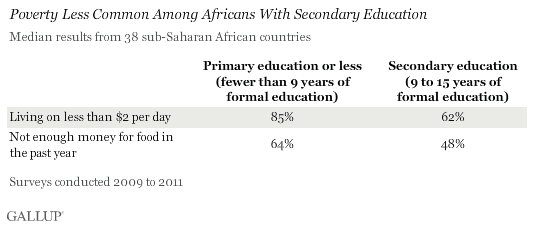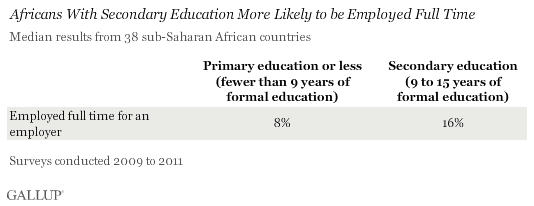WASHINGTON, D.C. -- Gallup polls from 2009 to 2011 find sub-Saharan Africans with a secondary education are less likely to live in poverty, stressing the need for universal access to this level of education. Across the 38 countries surveyed, a median of 85% of adults with a primary education or less are living on less than $2 per day (based on household income in international dollars), versus 62% of those with a secondary education. Those with a secondary education are also less likely to say there were times in the past year when they did not have enough money to buy food they or their families needed.

Though many sub-Saharan African countries have made great strides toward achieving universal primary education, access to secondary education remains spotty. There is only enough capacity for 36% of children in the region to enroll in secondary education, according to the United Nations Educational, Scientific and Cultural Organization's 2011 Global Education Digest. The report states that the rising number of primary school graduates and the need for more sophisticated workers with higher-level skills have increased the demand for secondary education in many sub-Saharan African countries.
Secondary schools are also often important venues for job placement. "[Secondary education] not only links initial education to higher education, but also connects the school system to the labor market," the report notes. Across the 38 sub-Saharan African countries studied, those with a secondary education are about twice as likely as those with a primary education or less to say they work full time for an employer.

Developing countries face significant challenges in increasing secondary education enrollment rates, including obtaining the funds to expand the education infrastructure. They also grapple with preventing high dropout rates in places where young people struggle daily with poverty and disease. However, Gallup data demonstrate that to the extent that governments overcome those obstacles, they will likely enjoy faster labor market development -- which in turn will empower residents to achieve better living standards for themselves and their families.
For complete data sets or custom research from the more than 150 countries Gallup continually surveys, please contact SocialandEconomicAnalysis@gallup.com or call 202.715.3030.
Survey Methods
Results are based on face-to-face interviews with 1,000 adults, aged 15 and older, conducted annually in 2009, 2010, and 2011 in 38 sub-Saharan African countries. Regional totals presented in this article are median percentages across all countries studied. For results based on each sample of national adults, one can say with 95% confidence that the maximum margin of sampling error ranged from ±3.5 percentage points to ±4.3 percentage points. The margin of error reflects the influence of data weighting. In addition to sampling error, question wording and practical difficulties in conducting surveys can introduce error or bias into the findings of public opinion polls.
For more complete methodology and specific survey dates, please review Gallup's Country Data Set details.
